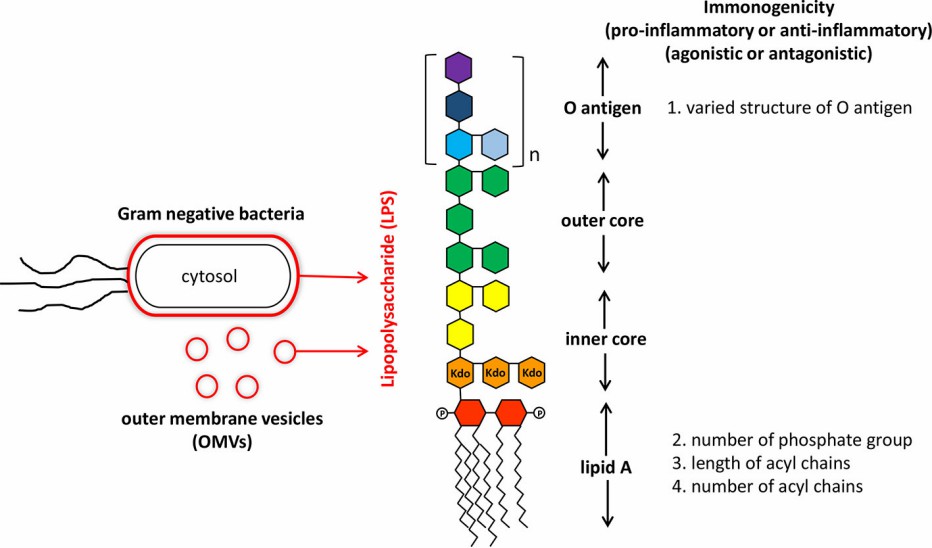Overview of Lipopolysaccharides (LPS)
LPS are biomacromolecules that exist in the outer membrane (OM) of almost all Gram-negative bacteria (GNB), and they are crucial for the formation and function of the OM. LPS is a pivotal cell wall component of GNB and are vital for bacterial viability and resistance to stress. They are conserved among GNB and are potent inducers of inflammatory responses. LPS are critical microbial triggers for the stimulation of innate immunity, which has a major impact on human health. They are ubiquitous in the environment and they can be inoculated from the environment through inhalation of dust. Evidence suggests that LPS may be linked to autoimmunity, obesity, depression and cellular aging.
Features of LPS
LPS performs multiple functions in GNB. The primary role of LPS is to serve as the key structural element of the OM of the GNB. For example, LPS contributes up to 80% to the OM of Escherichia coli and Salmonella. LPS plays a crucial role in maintaining the structural integrity of bacteria and protecting membranes from certain chemical attacks. Studies have shown that LPS forms a permeable barrier on the cell surface, thereby allowing GNB to exhibit a natural resistance to many antimicrobial compounds. Furthermore, LPS contributes to increasing the negative charge of the plasma membrane, which is crucial for the stability of the membrane structure. LPS plays an integral role in various host-parasite interactions and in protecting GNB from phagocytosis and lysis. LPS are ubiquitous in the environment, and as such, they can directly regulate the immune system and susceptibility to disease. LPS is essential to many GNB, and if the genes encoding LPS are abnormal, this can lead to the death of the bacteria.
Composition
LPS are common glycolipids, which consist of several parts: lipophilic lipid A, oligosaccharide core as well as O antigen. Lipid A is located in the outer leaflet of the OM whereas the oligosaccharide core and O antigen are displayed on the bacterial cell surface. Lipid A is responsible for the main biological activity of LPS. In addition, lipid A is closely linked to the toxic effects of GNB infection. The O antigen is located at the outermost layer of the LPS molecule and it is the main antigen for the host antibody (Ab) response. Currently, O antigen serology has emerged as an attractive strategy for typing LPS strains. It is worth noting that the O antigen domain plays a crucial role in the regulation of complement activation. The oligosaccharide structures of the core part are limited, and some regions are conserved between different strains. The outer core is usually composed of common hexoses and is usually more variable than the inner core. Importantly, there are many unusual sugars in the inner core.
 Fig.1 Structure of LPS from GNB. (Lin, 2020)
Fig.1 Structure of LPS from GNB. (Lin, 2020)
Abs at Creative Biolabs
With our rich experience and advanced platform, we are committed to providing a variety of Abs against LPS as well as Abs against microbial capsular polysaccharide with strong specificity, high sensitivity and good reproducibility. Our advanced hybridoma and phage display technologies provide a strong guarantee for Abs development. Our Abs are suitable for different applications like western blotting (WB), immunohistochemistry (IHC) and immunofluorescence (IF). In addition, we can customize various conjugations according to customer needs, such as biotin and fluorescent dyes.
If you are interested in our anti-LPS Abs, please feel free to contact us.
Reference
- Lin, Tzu-Lung, et al. "Like cures like: pharmacological activity of anti-inflammatory lipopolysaccharides from gut microbiome." Frontiers in Pharmacology 11 (2020): 554. Distributed under Open Access license CC By 4.0, without modification.
-
-
AibGenesis™ Anti-Brucella LPS Monoclonal Antibody (Mouse mAb) (CAT#: MAS-0524-YJ13)
- Host: Mouse
- Reactivity: Brucella
- Applications: ELISA
- Conjugations: Conjugation could be customized
-
-
-
AibGenesis™ Anti-R. solanacearum race 3 LPS Monoclonal Antibody (Human mAb) (CAT#: MAS-0524-YJ1)
- Host: Human
- Reactivity: R. solanacearum race 3
- Applications: ELISA; IF; WB
- Conjugations: Conjugation could be customized
-
-
-
AibGenesis™ Anti-B. pseudomallei/B. thailandensis LPS Monoclonal Antibody (Human mAb) (CAT#: MAS-0124-YJ32)
- Host: Human
- Reactivity: B. pseudomallei, B. thailandensis
- Applications: WB; ELISA
- Conjugations: Conjugation could be customized
-
-
-
AibGenesis™ Anti-S. typhi LPS Monoclonal Antibody (Mouse mAb) (CAT#: MAS-0524-YJ52)
- Host: Mouse
- Reactivity: S. typhi
- Applications: LF; ELISA; IF
- Conjugations: Unconjugated; Cy3; Cy5; Cy5.5; Cy7; FITC; HRP; Biotin
-
-
-
AibGenesis™ Anti-C. psittaci LPS Monoclonal Antibody (Mouse mAb) (CAT#: MAS-0524-YJ10)
- Host: Mouse
- Reactivity: C. psittaci
- Applications: ELISA
- Conjugations: Conjugation could be customized
-
-
-
AibGenesis™ Anti-B. mallei LPS Monoclonal Antibody (Human mAb) (CAT#: MAS-0124-YJ25)
- Host: Human
- Reactivity: B. mallei
- Applications: ELISA
- Conjugations: Conjugation could be customized
-
-
-
AibGenesis™ Anti-Bacteria Lipid A Monoclonal Antibody (Mouse mAb) (CAT#: MAS-0124-YJ37)
- Host: Mouse
- Reactivity: Bacteria
- Applications: ELISA; FuncS
- Conjugations: Conjugation could be customized
-
-
-
AibGenesis™ Anti-B. mallei LPS Monoclonal Antibody (Mouse mAb) (CAT#: MAS-0124-YJ24)
- Host: Mouse
- Reactivity: B. mallei
- Applications: ELISA
- Conjugations: Conjugation could be customized
-
-
-
AibGenesis™ Anti-C. trachomatis LPS Monoclonal Antibody (Mouse mAb) (CAT#: MAS-0524-YJ12)
- Host: Mouse
- Reactivity: C. trachomatis
- Applications: WB; ELISA; FuncS
- Conjugations: Conjugation could be customized
-
For Research Use Only. Do NOT use in humans or animals.